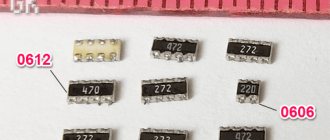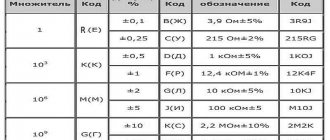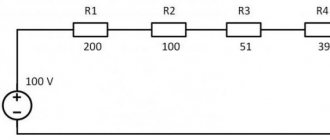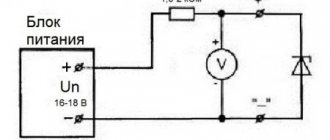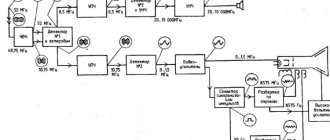What is a resistor?
Special components called resistors are designed specifically to create the precise amount of resistance added to a circuit. They are typically made from metal wire or carbon and are designed to maintain a stable resistance value over a wide range of environmental conditions. Unlike lamps, they do not emit light, but they do produce heat because they dissipate electrical energy in a working circuit. Typically, however, a resistor is not designed to generate useful heat, but simply to provide a precise amount of electrical resistance.
What is a resistor and what is it for?
A passive element that has a certain resistance (constant or variable) is called a resistor. No one will give you a more precise definition, but this simple formulation nevertheless reflects the main property of this radioelement.
To complete the picture, here is a definition from Wikipedia:
A resistor (English resistor, from Latin resisto - I resist) is a passive element of electrical circuits that has a certain or variable value of electrical resistance, designed to linearly convert current into voltage and voltage into current, limiting current, absorbing electrical energy, etc. A very widely used component in almost all electrical and electronic devices.
There are also resistances with nonlinear characteristics that change parameters depending on various conditions: temperature, voltage, light, etc. Although they are resistances, they have separate names (varistor, thermistor, etc.), slightly different designations and other technical characteristics. In this article we will talk about constant and variable resistors, but those that have linear characteristics (almost linear, since there is no ideal).
These elements are called either “resistor” or “resistance”. The first name comes from the Latin resisto, which translates as resistance. Both names reflect the main purpose of this element - to change the resistance of an electrical circuit. On circuits of European origin, a constant resistor is indicated as a small rectangle. On American diagrams, a different designation is adopted - in the form of a broken line. In any case, next to the icon there is the Latin letter R and a number that indicates the element number.
What a resistor looks like: the most typical types of fixed resistors and designation in diagrams
In small circuits, the nominal value may appear next to the designation; in large circuits, the type of resistor and its parameters are indicated in a separate table (specifications).
Designation of resistors on the diagram indicating the nominal resistance
No circuit can function without a resistor. Neither electric nor electronic. The purpose of resistors in a circuit can be as follows:
- to limit current;
- to create a voltage drop to a certain value.
For example, a certain current flows in a circuit, but you need to use an element that is not designed for such current. In this case, a resistor is installed, after which the current is reduced to the desired level. What does a resistor do in a circuit? Reduces the current to an acceptable value. In this case, they are often called current-limiting - based on the task they perform. They do the same with voltage, only in this case it is not the current that is calculated, but the voltage.
Types of resistors: appearance of constant resistances. On the right is an SMD resistor - designed for surface mounting
If we talk about appearance, most often they are a small cylinder, from the ends of which mounting legs extend. Most often they are made of wire, less often of metal tape. There are resistors in the form of a rectangular parallelepiped (ceramic) and in the form of a small rectangle (SMD technology) for surface mounting on printed circuit boards.
Symbols and resistor values in the diagram
The symbol for a resistor in the diagram according to GOST is a rectangle measuring 4 mm x 8 mm. In English-language literature, the designation of a resistor in the form of a sawtooth line is common:
Figure 1 – Symbolic graphic designation of a resistor
Resistor ohm values are usually shown on the diagram as numbers next to the symbol, and if there are multiple resistors in the circuit, they will be labeled with a unique identification number such as R1, R2, R3, etc. As you can see, resistor symbols can be shown horizontally or vertically:
Figure 2 – Designation of resistor values in the diagram (150 Ohm and 25 Ohm resistors)
Below are some examples of resistors of different types and sizes:
Figure 3 – Examples of resistors
The diagram can also show that the resistor has a variable and not a fixed resistance. This may be for the purpose of describing an actual physical device designed to provide adjustable resistance, or it may be to show some component that simply has unstable resistance:
Figure 4 – Symbol of a variable resistor
In fact, any time you see a component symbol with a diagonal arrow drawn, it means that the component has a variable value rather than a fixed value. This "modifier" symbol (diagonal arrow) is a standard addition to the identification of electronic components.
Designation of resistors on diagrams
From previous articles, we learned what a resistor is, what types and types of reristors are produced by modern industry. You also saw what resistors look like, now let’s look at the designation of resistors on the diagrams or the conventional graphic designation of resistors (UGO).
The symbolic graphic designation of resistors on the diagrams is displayed in accordance with GOST 2.728-74.
Figure 1 shows the general designation of a constant resistor and shows the dimensions according to which the resistor is applied to circuit diagrams.
Figure 1. General designation of a resistor in the diagram.
Above the UGO of the resistor is its serial number, the Latin letter R indicates that it belongs to the class of resistors. The nominal resistance of the resistor is applied under the UGO.
All resistors have a power dissipation rating. This is the value of the current power on the resistor at which it can operate for a long time and not overheat (usually room temperature is taken into account? 23°) .
The designation of resistor power in the diagrams is shown in Figure 2.
Figure 2. Designation of resistor power in the diagram. a)0.125 W; b)0.25 W; c)0.5 W; d)1 W; e)2 W; e)5 W.
The designation of variable resistors in the diagrams is shown in Figure 3.
Figure 3. Designation of variable resistors in the diagram. a) general designation; b) with rheostatic switching on; c) with nonlinear regulation.
The designation of padding resistors in the diagrams is shown in Figure 4.
Figure 4. Designation of trimming resistors in the diagram. a) general designation; b) with rheostatic switching on; c) variable with adjustment.
The given designations of resistors in the diagrams, as already mentioned, correspond to GOST, however, currently in the literature (especially in foreign literature) you can find other designations of resistors.
These designations are shown in Figure 5.
Figure 5. Designation of resistors used in foreign literature. a) constant resistor; b) variable resistor.
DID YOU LIKE THE ARTICLE? SHARE WITH YOUR FRIENDS ON SOCIAL NETWORKS!
Related materials:
- Resistors. Types of resistors
- Types of resistors
- Connection of resistors
- Dependence of electrical resistance on the cross-section, length and material of the conductor
- Dependence of conductor resistance on temperature
Comments
Kostik 11/19/2014 06:50 where is the photoresistor
Quote
Update list of comments
Add a comment
Variable resistors
Variable resistors must have some physical means of adjustment, either a rotating shaft or a lever that can be moved to change the amount of electrical resistance. The photo below shows devices called potentiometers, which can be used as variable resistors:
Figure 5 – Potentiometer
Conventional graphic designation of variable resistors
UGO variable resistors are applied to the circuit diagram in the same way as fixed resistors, according to the state standard GOST 2.728-74. The table shows an image of these resistors.
The photo below shows variable and trimming resistors.
Rated power of resistors
Because resistors dissipate thermal energy as electrical currents through them overcome the "friction" of their resistance, resistors are also rated in terms of how much thermal energy they can dissipate without overheating and causing damage. Naturally, this rated power is indicated in physical units of measurement, “watts”. Most resistors used in small electronic devices such as portable radios are rated at 1/4 (0.25) W or less. The power rating of any resistor is roughly proportional to its physical size. Notice in the first photo of the resistors how the power rating relates to the size: the larger the resistor, the higher the power rating. Also note that resistance (in ohms) has nothing to do with size! While it may now seem pointless to have a device that does nothing other than resist electrical current, resistors are extremely useful devices in circuits. Because they are simple and so commonly used in the world of electricity and electronics, we will spend a lot of time analyzing circuits consisting of just resistors and power supplies.
RESISTOR DESIGNATIONS
The symbols of resistors in the diagrams are shown in Figure 1.
The top row shows:
- general designation;
- 0.125 W resistor;
- 0.25 W;
- 0.5 W;
- 1 W.
The power of a resistor of 1 W or more is indicated in the diagrams by placing the corresponding Roman numeral inside its designation.
In addition, on the diagram next to the designation the following may be indicated (second row, from left to right):
- letter designation of the resistor and its serial number,
- nominal resistance value,
- letter designation and denomination,
- resistor power in combination with all of the above options.
What are resistors useful for?
For a practical illustration of the usefulness of resistors, see the photo below. This is a picture of a printed circuit board: an assembly consisting of insulating layers of fiberglass laminate and a layer of conductive copper traces into which components can be inserted and secured using a low-temperature welding process called "soldering." The various components on this PCB are identified by printed labels. Resistors are designated by any label starting with the letter "R".
Figure 6 – Example of resistors on a printed circuit board
This particular circuit board is an addition to the computer called a "modem" that allows digital information to be transmitted over telephone lines. On the board of this modem you can see at least a dozen resistors (all with a nominal power dissipation of 0.25 W). Each of the black rectangles (called "integrated circuits" or "microcircuits" or "chips") also contains its own resistor array required for operation. Another PCB example shows resistors packaged in even smaller packages called SMD (“surface mount device”). This particular circuit board is the underside of a computer's hard drive; and again the resistors soldered to it are indicated by marks starting with the letter “R”:
Figure 7 – Example of resistors on a printed circuit board
There are over a hundred surface mount resistors on this PCB, and this number of course does not include the resistors built into the black "chips". These two photos should convince anyone that resistors (devices that “merely” prevent electrical current from flowing) are very important components in the field of electronics!
"Load" on circuit diagrams
In diagrams, resistor symbols are sometimes used to illustrate a general type of device that does something useful with electrical energy. Any unspecified electrical device is usually called a load, so if you see a diagram with a resistor symbol labeled "load", especially in an educational circuit diagram explaining some concepts unrelated to the actual use of electricity, that symbol may simply be some kind of shorthand something even more practical than a resistor.
The simplest circuit diagram
Correct designation of resistors and other elements on diagrams is the main requirement of state standards when designing electronic and electrical products. The standard establishes rules for the symbols of resistors, capacitors, inductors and other circuit components. The diagram indicates not only the designation of a resistor or other circuit element, but also its rated resistance and power, and for capacitors, the operating voltage. Below is an example of the simplest circuit diagram with elements designated according to the standard.
Knowing all the conventional graphic symbols and reading alphanumeric codes for circuit elements will make it easy to understand the principle of operation of the circuit. This article discusses only resistors, but there are quite a lot of circuit elements.
Resistor Circuit Analysis
To summarize what we've learned in this article, let's analyze the following diagram, determining what we can from the information provided:
Figure 8 – Example circuit
All we are given here to start with is the battery voltage (10 volts) and the current in the circuit (2 amps). We do not know the resistance of the resistor in ohms or the power it dissipates in watts. Recalling the formulas of Ohm's law, we find two equations that give us answers based on the known values of voltage and current:
\(R=\frac{E}{I} \qquad and \qquad P=IE\)
By substituting the known values of voltage (E) and current (I) into these two equations, we can determine the circuit resistance (R) and power dissipation (P):
\(R = \frac{10\V}{2\A} = 5\Ohm\)
\(P = (2\A)(10\V) = 20\W\)
For the given circuit conditions (10 V and 2 A), the resistor should be 5 ohms. If we were to design the circuit to operate at these values, we would have to use a resistor with a minimum power rating of 20 W, otherwise it would overheat and fail.
Materials from which resistors are made
Throughout the world you can find resistors made from a wide variety of materials, each of which has its own properties and specific applications. Most electronics engineers use the types below.
Wirewound resistors
Figure 9 - Wirewound Resistors
Wirewound resistors are made by winding high-resistance wire in a spiral around a non-conducting core. They are usually used where high precision or high power is needed. The core is usually made of ceramic or fiberglass and the resistive wire is made of nickel-chromium alloy, which is not suitable for applications above 50 kHz. The advantages of wirewound resistors are low noise level and resistance to temperature fluctuations. Resistors are available with resistance values from 0.1 to 100 kOhm and with accuracy from 0.1% to 20%.
Metal film resistors
Figure 10 - Metal film resistors
For metal film resistors, nichrome or tantalum nitride is usually used. The resistive material is usually a combination of ceramic material and metal. The resistance value is changed by cutting a spiral pattern into the film, much like carbon film, using a laser or abrasive. Metal film resistors are generally less stable with temperature changes than wirewound resistors, but cope better with higher frequencies.
Metal Oxide Film Resistors
Figure 11 - Metal Oxide Film Resistors
Metal oxide resistors use metal oxides such as tin oxide, which makes them slightly different from metal film resistors. These resistors are reliable and stable and operate at higher temperatures than metal film resistors. For this reason, metal oxide film resistors are used in applications requiring high wear resistance.
Foil resistors
Figure 12 - Foil Resistors
Developed in the 1960s, the foil resistor is still one of the most accurate and stable types of resistors you will find, used in applications with high precision requirements. The resistive element consists of a thin bulk metal foil, which is glued to a ceramic substrate. Foil resistors have a very low temperature coefficient of resistance (TCR).
Carbon composite resistors
Figure 13 - Carbon Composite Resistors
Until the 1960s, carbon composite resistors were the standard for most applications. They are reliable, but not very accurate (their tolerance cannot be better than about 5%). The resistive element of carbon resistors uses a mixture of fine carbon particles and a non-conductive ceramic material. The resistive substance is shaped into a cylinder and baked. The amount of resistance is determined by the dimensions of the case and the ratio of carbon and ceramics. Using more carbon in the process means lower resistance. Carbon composite resistors are still useful for certain applications due to their ability to withstand high power pulses, a good example application would be a power supply.
Carbon Film Resistors
Carbon film resistors are a thin carbon film (cut in a spiral to increase the resistive path) on an insulating cylindrical core. This design allows for a more accurate resistance value and also increases the resistance value. Carbon film resistors are much more accurate than carbon composite resistors. For applications requiring stability at high frequencies, special carbon film resistors are used.
Key Performance Indicators (KPI)
Key resistor performance indicators for each material can be found below:
Key resistor performance indicators by material
| Characteristic | Metal film resistors | Thick film resistors | Thin Film Resistors | Carbon composite resistors | Carbon Film Resistors |
| Operating temperature range, °C | -55 … +125 | -55 … +130 | -55 … +155 | -40 … +105 | -55 … +155 |
| Maximum temperature coefficient of resistance | 100 | 100 | 15 | 1200 | 250–1000 |
| Maximum voltage, V | 250–350 | 250 | 200 | 350–500 | 350–500 |
| Noise, µV per 1 V applied DC voltage | 0,5 | 0,1 | 0,1 | 4 | 5 |
| Insulation resistance, kOhm | 10 | 10 | 10 | 10 | 10 |
| Change in soldering resistance, % | 0,20 | 0,15 | 0,02 | 2 | 0,50 |
| Change in resistance when exposed to high temperature and humidity, % | 0,50 | 1 | 0,50 | 15 | 3,5 |
| Change in resistance during long-term storage, % | 0,10 | 0,10 | 0,00 | 5 | 2 |
| Change in resistance during operation for 2000 hours at a temperature of 70°C, % | 1 | 1 | 0,03 | 10 | 4 |
Variable resistor series
With the introduction of GOST 13453-68, an alphanumeric system of abbreviated notations began to be used, depending on the group and properties of resistors. The letters indicate the product group:
- C – constant resistors;
- SP – variable resistors.
The number indicates the type of resistor depending on the manufacturing technology and material:
- 1 – non-wire thin-layer carbon and boron carbon;
- 2 – non-wire thin-layer metal film and metal oxide;
- 3 – non-wire composite films;
- 4 – non-wire composite volumetric;
- 5 – wire;
- 6 – non-wire thin-layer metallized.
After the first digit, a hyphen is followed by a second digit(s), which indicate the registration number of a specific type of resistor. For example: SP3-3, SP5-22.
Since 1980, the designation of resistors has been carried out in accordance with OST 11.074.000-78. The resistor designation consists of three elements:
- First element: a letter or combination of letters to designate a subclass (P - constant resistors, RP - variable resistors, NR - sets of resistors);
- Second element: a number indicating a group of resistors according to the material of the resistive element (1 – non-wire, 2 – wire and metal foil);
- The third element is the registration number of the specific type of resistor.
For example: RP1-54.
Summary
- Devices called resistors are designed to provide precise resistance values in electrical circuits. Resistors are rated by both their resistance (Ohms) and their ability to dissipate thermal energy (W).
- The rated resistance of a resistor cannot be determined by its physical size, although the size can give an approximate value for the power rating. The larger the resistor, the more power it can dissipate without being damaged.
- Any device that uses electricity to perform some useful task is usually called a load. Sometimes the resistor symbol is used in circuits to represent an unspecified load rather than an actual resistor.
Original article:
- Resistors
Resistor resistance designation
The minimum power dissipation of the resistor (from 0.05 to 5 W) is indicated by special signs placed inside the symbol (Fig. 3). Note that mm should not touch the contour of the resistor symbol.
Rice. 3. Designation of resistor power.
On the circuit diagram, the nominal resistance of the resistor is indicated next to the symbol (Fig. 4). According to GOST 2.702-7S, resistance from 0 to 999 Ohms is indicated by a number without a unit of measurement (2.2; 33, 120...), from 1 to 999 kOhm - by a number with a letter k (47 k, 220 k, 910 k, etc. ), over 1 megaohm - a number with the letter M (1 M, 3.6 M, etc.).
Rice. 4. Resistance designation for resistors on diagrams.
On domestically produced resistors, the nominal resistance, the permissible deviation from it, and, if dimensions allow, the rated dissipation power are indicated in the form of a full or abbreviated (coded) designation.
According to GOST 11076-69, resistance units in the coded system are designated by the letters E (ohm), K (kilo-ohm) and M (mega-ohm). So, resistors with a resistance of 47 Ohms are marked 47E, 75 Ohms - 75E, 12 kOhms - 12K, 82 kOhms - 82K, etc.
Resistances from 100 to 1000 Ohms and from 100 to 1000 kOhms are expressed in fractions of kilo-ohm and mega-ohm, respectively, and the corresponding unit of measurement is placed in place of zero and comma:
- 180 Ohm = 0.18 kOhm = K18;
- 910 Ohm = 0.91 kOhm = K91;
- 150 k0m = 0.15 MOhm = M15;
- 680 k0m = 0.68 MOhm = M68, etc.
If the nominal resistance is expressed as an integer with a fraction, then the unit of measurement is placed in place of the decimal point: 2.2 Ohm - 2E2; 5.1 kOhm -5K1; 3.3 MOhm - ZMZ, etc.
Coded letter designations are also established for permissible resistance deviations from the nominal value. The permissible deviation of ±1% corresponds to the letter P, ±2% to L, ±5% to I, ±10% to C, ±20% to B. Thus, the inscription on the body of the K75I resistor indicates a nominal resistance of 750 Ohms with a permissible deviation of ±5%; inscription MZZV - 330 kOhm ±20%, etc.





